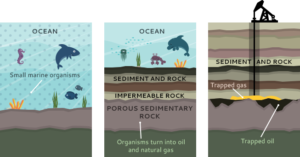Jan
28
Prepping the Earth for the Industrial Revolution
This week on Science Sunday…

The following citation is another from Improbable Planet by Hugh Ross, specifically the 14th chapter, “Finishing Touches”. In this particular section, Ross looks at extinction during the Devonian period and speciation during the Carboniferous. It is all fascinating, especially when one considers the multitude of factors involved that had to be fine-tuned and -timed.
But, the part I wanted to highlight here is the long-term planning that went into providing us moderns with things like coal, limestone, and petroleum that we would need to advance civilization via industrialization hundreds of millions of years later.
— — —
About 374 million years ago, a major extinction event wiped out nearly 50 percent of genera. Relatively soon thereafter, about 359 million years ago, another extinction even took out 44 percent of the higher-level marine vertebrates. With this event, the Devonian period came to a close. The net impact of these two late Devonian extinctions was the loss of 55-60 percent of all Devonian genera and roughly 70-82 percent of all Devonian species. Scientists have yet to determine what, exactly, caused these extinctions. We do know that an anoxic [i.e., oxygen-less] black shale layer accompanied the latter event.
The lack of oxygen in the ocean inhibited decay. So partially decayed organic matter accumulated on and in the porous rocks of the vast reefs that existed during the late Devonian. This organic matter ultimately became a wealth of petroleum.
The introduction of advanced vascular plants’ engineering systems (xylem and phloem conduit systems) during the latter part of the Devonian might well have contributed to the marine life extinctions. These systems allowed plant heights to jump from 30 centimeters to 30 meters (1 foot to 100 feet). The roots of these huge plants fractured upper bedrock layers, exposing more silicates to weathering. This enhanced weathering, in turn, dumped enormous amounts of nutrients into rivers, lakes, and oceans (too much of a good thing), causing eutrophication (explosive growth of plants and algae and the subsequent death and decay of those organisms that remove huge quantities of oxygen from the water) and anoxia.
Increased silicate weathering, combined with burial of organic carbon, caused yet another dramatic drop in atmospheric carbon dioxide levels, from 2,200 parts per million down to 800 parts per million by volume. This drop again helped overcome the effects of increasing solar luminosity, enough to transition Earth out of the warm Devonian into the relatively cool climate that persisted throughout the Carboniferous and Permian periods.

Following the Late Devonian extinction events came the Carboniferous mass speciation event. During this next period, from 359 to 305 million years ago, the dominant animals were amphibians, and vast forests grew up on virtually all Earth’s landmasses. Trees pumped up atmospheric oxygen to about 30 percent by volume and contributed to the drawdown of atmospheric carbon dioxide.
Carboniferous trees averaged a bark-to-wood ratio of 8 to 1, compared with modern trees at a ratio of 1 to 4. Given that Carboniferous animals, fungi, and bacteria could not digest bark, vast quantities of it were deposited in Earth’s crust, later to become the enormous coal beds found in Carboniferous layers all over the world — a critical factor in the launch of the Industrial Revolution.
With added oxygen in the atmosphere, wildfires grew more frequent and extensive. Increased wildfires enhanced Earth’s soils with an added abundance of charcoal, plus nutrients, conditioning, and water retention characteristics that supported the more advanced vascular trees and plants to arrive during later geological periods.
During the latter part of the Carboniferous period, crinoids, brachiopods, and bryozoans — all marine invertebrates — became especially abundant and diverse. Their great abundance and diversity helped produce large stores of limestone and petroleum. As with coal, these deposits eventually helped initiate and sustain industrialization.
— — —
The more we learn, the more we see God’s plans and provisional activity from Creation and throughout history. Amazing!















